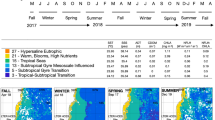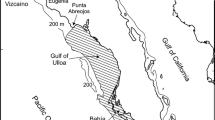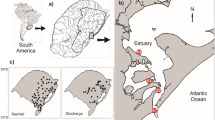Abstract
Despite considerable attention to the role of parrotfish assemblages in maintaining coral reef ecosystem integrity, little is known about the factors affecting parrotfish settlement, which could play an important role in structuring parrotfish assemblages. Here, I expand on a previous study that sought to identify environmental correlates of the temporal patterns of recruitment of Sparisoma parrotfishes onto standardized settlement units sampled at 52 consecutive 10-day intervals over an uninterrupted 17-month period on the west coast of Barbados (W.I.). By (1) including previously unavailable satellite-derived island-wide current speed data in the analyses and (2) using a more flexible (non-linear) analytical framework, the re-analysis increased the variance explained from 24% to 74%. Furthermore, island-wide current speed had stronger predictive power than all of the previously identified environmental correlates of Sparisoma recruitment, i.e. sea surface temperature and chlorophyll a concentration, and lunar phase, underscoring a dominant role for large-scale, transport-related physical processes in driving parrotfish settlement. Relationships between Sparisoma recruitment and the environmental correlates were better explained as non-linear functions, with a hump-shaped relationship for current speed. Most variability in current speed reflected external forcing due to the passage through Barbados of a large, slow-moving, low-salinity intrusion of South American riverine origin. Considering the high recruitment variance explained and that satellite-derived data on key environmental correlates are publicly available, prediction of temporal patterns of parrotfish settlement in Barbados might be more feasible than previously expected.




Similar content being viewed by others
References
Adam TC, Kelley M, Ruttenberg BI, Burkepile DE (2015) Resource partitioning along multiple niche axes drives functional diversity in parrotfishes on Caribbean coral reefs. Oecologia 179(4):1173–1185. https://doi.org/10.1007/s00442-015-3406-3
Bellwood DR, Hughes TP, Folke C, Nystrom M (2004) Confronting the coral reef crisis. Nature 429(6994):827–833. https://doi.org/10.1038/nature02691
Belušić A, Herceg-Bulić I, Bencetić Klaić Z (2015) Using a generalized additive model to quantify the influence of local meteorology on air quality in Zagreb. Geofizika 32(1):47–77. 10.15233/gfz.2015.32.5
Bonaldo RM, Hoey AS, Bellwood DR (2014) The ecosystem roles of parrtofishes on tropical reefs. Oceanogr Mar Biol 52:81–132
Bowman MJ, Stansfield KL, Fauria SJ, Wilson TC (1994) Coastal ocean circulation near Barbados, W. I. Spring 1990 and 1991. J Geophys Res 99(C8):16131–16142
Cardoso SC, Soares MC, Oxenford HA, Côté IM (2009) Interspecific differences in foraging behaviour and functional role of Caribbean parrotfish. Mar Biodivers Rec 2. https://doi.org/10.1017/s1755267209990662
Cowen RK (2002) Larval dispersal and retention consequences for population connectivity. In: Sale PF (ed) Coral reef fishes: dynamics and diversity in a complex ecosystem. Academic Press, San Diego, pp 149–170
Cowen R, Castro LR (1994) Relation of coral reef fish larval distributions to island scale circulation around Barbados, West Indies. Bull Mar Sci 54(1):228–244
Cowen RK, Sponaugle S, Paris CB, Lwiza KMM, Fortuna JL, Dorsey S (2003) Impact of North Brazil current rings on local circulation and coral reef fish recruitment to Barbados, West Indies. In: Goni GJ, Rizzoli PM (eds) Interhemispheric water exchange in the Atlantic Ocean. Elsevier, Amsterdam, pp 443–462
Doherty PJ (2002) Variable replenishment and the dynamics of reef fish populations. In: Sale PF (ed) Coral reef fishes: dynamics and diversity in a complex ecosystem. Academic Press, San Diego, pp 327–359
Frantatoni DM, Glickson DA (2002) North Brazil current ring generation and evolution observed with SeaWiFS. J Phys Oceanogr 32:1058–1074
Kelly PS, Lwiza KMM, Cowen RK, Goni GJ (2000) Low-salinity pools at Barbados, West Indies: their origin, frequency, and variability. J Geophys Res 105(C8):19699–19708
Kidd RJ (1978) The influence of Amazon River discharge and the "island mass effect" upon distribution, species diversity and numbers of zooplankton near Barbados, West Indies. McGill University, Montreal
Leis JM (2006) Are larvae of demersal fishes plankton or nekton? Adv Mar Biol 51:57–141
McAfee ST, Morgan SG (1996) Resource use by five sympatric parrotfishes in the San Blas Archipelago, Panama. Mar Biol 125(3):427–437
Munro JL, Gaut VC, Thompson R, Reeson PH (1973) The spawning seasons of Caribbean reef fishes. J Fish Biol 5:69–84
Overholtzer KL, Motta PJ (1999) Comparative resource use by juvenile parrotfishes in the Florida Keys. Mar Ecol Prog Ser 177:177–187
R Core Team (2014) R: A language and environment for statistical computing. R Foundation for Statistical Computing, Vienna, Austria. URL http://www.R-project.org/
Robertson DR, Van Tassell J (2015) Shorefishes of the greater Caribbean: online information system. Version 1.0. Smithsonian Tropical Research Institute, Balboa, Panama
Robertson DR, Warner RR (1978) Sexual patterns in the labroid fishes of the western Caribbean, II: the parrotfishes (Scaridae). Smithson Contrib Zool 255:1–26
Robertson DR, Karg F, de Moura RL, Victor BC, Bernardi G (2006) Mechanisms of speciation and faunal enrichment in Atlantic parrotfishes. Mol Phylogenet Evol 40(3):795–807. https://doi.org/10.1016/j.ympev.2006.04.011
Schmitt RJ, Holbrook SJ (2002) Spatial variation in concurrent settlement of three damselfishes: relationships with near-field current flow. Oecologia 131(3):391–401
Sponaugle S, Cowen RK (1996) Near-shore patterns of coral reef fish larval supply to Barbados, West Indies. Mar Ecol Prog Ser 133:13–28
Sponaugle S, Pinkard DR (2004) Impact of variable pelagic environments on natural larval growth and recruitment of the reef fish Thalassoma bifasciatum. J Fish Biol 64(1):34–54. https://doi.org/10.1046/j.1095-8649.2003.00279.x
Sponaugle S et al (2002) Predicting self-recruitment in marine populations: biophysical correlates and mechanisms. Bull Mar Sci 70(1):341–375
Vallès H, Kramer DL, Hunte W (2006) A standard unit for monitoring recruitment of fishes to coral rubble. J Exp Mar Biol Ecol 336:171–183
Vallès H, Kramer DL, Hunte W (2008) Temporal and spatial patterns in the recruitment of coral-reef fishes in Barbados. Mar Ecol Prog Ser 363:257–272
Vallès H, Hunte W, Kramer DL (2009a) Variable temporal relationships between environment and recruitment in coral reef fishes. Mar Ecol Prog Ser 379:225–240. https://doi.org/10.3354/meps07886
Vallès H, Kramer DL, Hunte W (2009b) Differential effect of early post-settlement processes on the abundance of two concurrently settling coral reef fishes. Proceedings of the 11th International Coral Reef Symposium 1:341–345
Vallès H, Gill D, Oxenford HA (2015) Parrotfish size as a useful indicator of fishing effects in a small Caribbean island. Coral Reefs 34:789–801. https://doi.org/10.1007/s00338-015-1295-x
Victor BC (2015) How many coral reef fish species are there? Cryptic diversity and the new molecular taxonomy. In: Mora C (ed) Ecology of fishes on coral reefs. Cambridge University Press, Cambridge, pp 76–87
Wood SN (2006) Generalized additive models: an introduction with R. Chapman & Hall/CRC Press. Taylor & Francis Group, Boca Raton, FL. p 410
Zuur AF, Ieno EN, Smith GM (2007) Analyzing ecological data. Springer, USA
Acknowledgments
I am grateful to the staff of the Physical Oceanography Distributed Active Archive Center (PODAAC) for their assistance with sea surface current data. I am also deeply indebted to all those who made the original research project possible: D. L. Kramer and W. Hunte for their overall support; the many volunteer field assistants; the staff of the Bellairs Research Institute of McGill University and University of the West Indies at Cave Hill for logistical support; B. Victor for specimen identification; and J. Horrocks and B. Selliah for field accommodation. The original research project was partially funded by UWI grants to W. Hunte and a Natural Sciences and Engineering Research Council of Canada Discovery grant to D. L. Kramer Additional support came from a PADI-AWARE project grant and a Small Scheme grant from the Fisheries Society of the British Isles to H.V. The Waddell Aquatics Dive Shop in Montreal partially sponsored some of the diving equipment. Two anonymous reviewers provided useful comments on an earlier version of this manuscript.
Author information
Authors and Affiliations
Corresponding author
Rights and permissions
About this article
Cite this article
Vallès, H. Parrotfish recruitment revisited: a key role for sea surface currents. Environ Biol Fish 100, 1649–1657 (2017). https://doi.org/10.1007/s10641-017-0673-3
Received:
Accepted:
Published:
Issue Date:
DOI: https://doi.org/10.1007/s10641-017-0673-3




